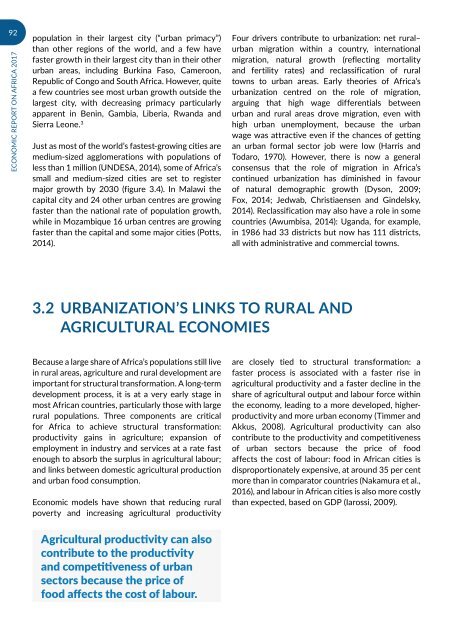URBANIZATION AND INDUSTRIALIZATION
Economic%20Report%20on%20Africa%202017%20UNECA
Economic%20Report%20on%20Africa%202017%20UNECA
You also want an ePaper? Increase the reach of your titles
YUMPU automatically turns print PDFs into web optimized ePapers that Google loves.
92<br />
ECONOMIC REPORT ON AFRICA 2017<br />
population in their largest city (“urban primacy”)<br />
than other regions of the world, and a few have<br />
faster growth in their largest city than in their other<br />
urban areas, including Burkina Faso, Cameroon,<br />
Republic of Congo and South Africa. However, quite<br />
a few countries see most urban growth outside the<br />
largest city, with decreasing primacy particularly<br />
apparent in Benin, Gambia, Liberia, Rwanda and<br />
Sierra Leone. 3<br />
Just as most of the world’s fastest-growing cities are<br />
medium-sized agglomerations with populations of<br />
less than 1 million (UNDESA, 2014), some of Africa’s<br />
small and medium-sized cities are set to register<br />
major growth by 2030 (figure 3.4). In Malawi the<br />
capital city and 24 other urban centres are growing<br />
faster than the national rate of population growth,<br />
while in Mozambique 16 urban centres are growing<br />
faster than the capital and some major cities (Potts,<br />
2014).<br />
Four drivers contribute to urbanization: net rural–<br />
urban migration within a country, international<br />
migration, natural growth (reflecting mortality<br />
and fertility rates) and reclassification of rural<br />
towns to urban areas. Early theories of Africa’s<br />
urbanization centred on the role of migration,<br />
arguing that high wage differentials between<br />
urban and rural areas drove migration, even with<br />
high urban unemployment, because the urban<br />
wage was attractive even if the chances of getting<br />
an urban formal sector job were low (Harris and<br />
Todaro, 1970). However, there is now a general<br />
consensus that the role of migration in Africa’s<br />
continued urbanization has diminished in favour<br />
of natural demographic growth (Dyson, 2009;<br />
Fox, 2014; Jedwab, Christiaensen and Gindelsky,<br />
2014). Reclassification may also have a role in some<br />
countries (Awumbisa, 2014): Uganda, for example,<br />
in 1986 had 33 districts but now has 111 districts,<br />
all with administrative and commercial towns.<br />
3.2 <strong>URBANIZATION</strong>’S LINKS TO RURAL <strong>AND</strong><br />
AGRICULTURAL ECONOMIES<br />
Because a large share of Africa’s populations still live<br />
in rural areas, agriculture and rural development are<br />
important for structural transformation. A long-term<br />
development process, it is at a very early stage in<br />
most African countries, particularly those with large<br />
rural populations. Three components are critical<br />
for Africa to achieve structural transformation:<br />
productivity gains in agriculture; expansion of<br />
employment in industry and services at a rate fast<br />
enough to absorb the surplus in agricultural labour;<br />
and links between domestic agricultural production<br />
and urban food consumption.<br />
Economic models have shown that reducing rural<br />
poverty and increasing agricultural productivity<br />
are closely tied to structural transformation: a<br />
faster process is associated with a faster rise in<br />
agricultural productivity and a faster decline in the<br />
share of agricultural output and labour force within<br />
the economy, leading to a more developed, higherproductivity<br />
and more urban economy (Timmer and<br />
Akkus, 2008). Agricultural productivity can also<br />
contribute to the productivity and competitiveness<br />
of urban sectors because the price of food<br />
affects the cost of labour: food in African cities is<br />
disproportionately expensive, at around 35 per cent<br />
more than in comparator countries (Nakamura et al.,<br />
2016), and labour in African cities is also more costly<br />
than expected, based on GDP (Iarossi, 2009).<br />
Agricultural productivity can also<br />
contribute to the productivity<br />
and competitiveness of urban<br />
sectors because the price of<br />
food affects the cost of labour.


